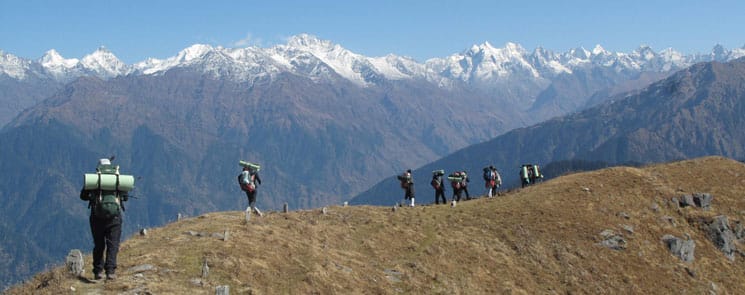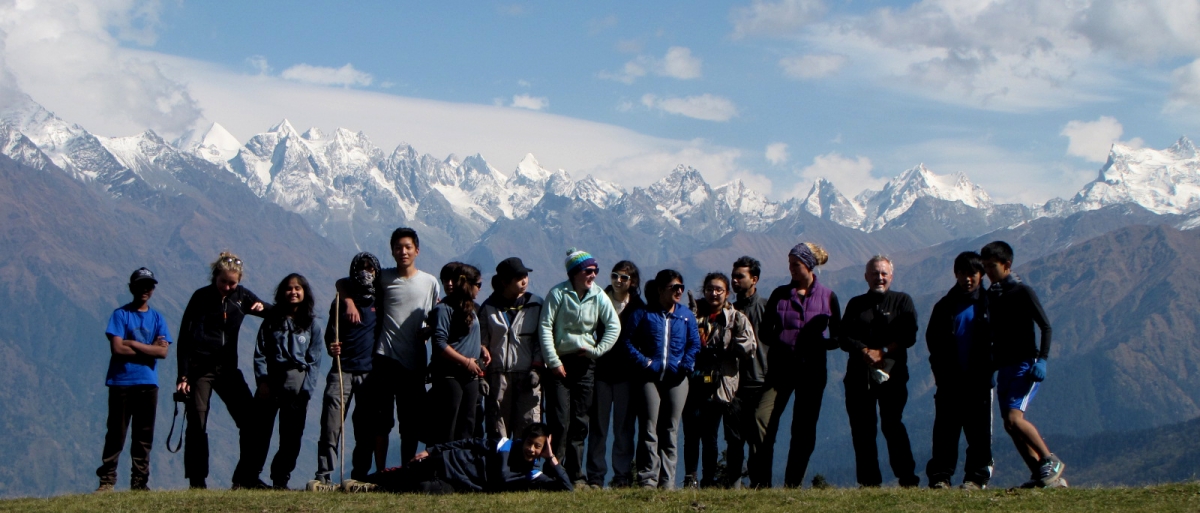Woodstock School students trek to Baraadsar Lake

After two failed attempts, the school's ‘outdoor education’ wing made a successful trek up to the 4,400 meter high lake in the Western Garhwal range of the Himalayas
Setting off before daybreak, a wavering string of headlamps traverses the icy darkness. More than a kilometre farther on and further up, a second line of lights is visible, ascending the shadowy ridge, like a wayward constellation marching toward the sky. Two teams of students work their way toward the high pass, which remains hidden from sight. It is cold and silent, except for the crunch of boots and the ragged breathing of trekkers. From time to time, one of the headlamps turns away from the path, glancing nervously into the surrounding blackness.

Three days earlier, the expedition spent a night on the Dhaldhar meadows above the Rupin Valley. Some of the students sat around stargazing, while others lay in their tents, cocooned in sleeping bags. Shepherds were camped nearby with their animals. Suddenly, a commotion broke out, cries of alarm and the frantic drumbeat of hooves… then silence. Next morning, less than 300 meters from camp, the students came upon bloodstains crossing the path and pugmarks of a leopard. Some of them scrambled down the hill where they found a dead mule, blood oozing from puncture wounds in its throat. The leopard had disembowelled its victim and eaten part of the mule for breakfast.
Today is the final push. Though anxious about crossing the pass, the predator’s attack is still fresh in their minds. But the sky is brightening and dawn erases the darkness. “It was amazing, like watching a time lapse film,” Zach recalls, “sunlight spilling down the ridges.”
“For me the most beautiful sight was the panorama of Himalayan peaks,” Ishika says. She had done several treks before – earning the Duke of Edinburgh’s bronze, silver and gold awards for expeditions in places like Oman, Cyprus and Scotland. “But this was much harder, much higher, with so much more to see.”
“For me, it was my first trek,” Younjung admits. “In the beginning, I wasn’t going to sign up. My friends didn’t think I could make it. We don’t have big mountains like this in Korea.”
All these students were part of a nine day expedition from Woodstock School to Baraadsar Lake, a pristine pond at 4,400 meters above sea level, on the border of Uttarakhand and Himachal Pradesh. Nineteen students, accompanied by three staff members, completed this trek in October, 2013. It was Woodstock’s third attempt to reach Baraadsar Lake. In previous years, their expeditions had been forced to turn back because of dangerous snow conditions, time constraints and exhaustion. On this third try, they successfully reached their goal.

“More than the physical challenge was the sense of accomplishment that comes from working together,” says Andrew Hepworth, Head of Outdoor Education and Woodstock. He led the 2012 and 2013 expeditions. “We had a fantastic trek last year, even though we didn’t make it to the lake. The best part was seeing how the students interpreted their experiences in light of a failed attempt.”
Younjung agrees. “At the beginning, we decided we weren’t going to judge each other. It didn’t matter if you were first or last.”
For much of the route, Zach was line leader for his team. He believes in the saying, “If you want to go fast, go alone. If you want to go far, go together." Zach has done a lot of backpacking in the Sierra Nevadas, near his home in California.

Ishika laughs and shakes her head. “Every time, after we stopped to rest, and Zach would tell us to start moving again, I wanted to punch him.” But she agrees, it was the togetherness of the team that kept her going. With students from half a dozen different countries, varying backgrounds and levels of experience, the Baraadsar Lake expedition exemplifies Woodstock’s goal of educating global citizens in a Himalayan environment.
Located in the hill station of Mussoorie, in the first range of the Garhwal Himalaya, Woodstock has a long tradition of outdoor education that reaches back to the school’s founding in 1854. Generations of students have been inspired by the natural surroundings of Uttarakhand, its forests, mountains, rivers and wildlife. Woodstock’s principal, Dr. Jonathan Long, is convinced that students learn from their experiences outdoors. Quoting Plato, he insists, “Young people should be educated in places of outstanding natural beauty because the beauty without finds resonance with the beauty of reason within.”
In 2003, Woodstock opened a special facility dedicated to Outdoor Learning. The Hanifl Centre for Outdoor and Environmental Education promotes an interest in the outdoors amongst Woodstock students, as well as visiting groups from other schools and colleges. Along with its own Gap Semester programme, the centre hosts the University of Pittsburgh’s Semester in the Himalayas, which offers college courses and field trips that focus on Himalayan geography, culture and science. Students from a variety of institutions in India also get an opportunity to learn through camping, trekking, mountain biking, river rafting and other outdoor activities. Director of the Hanifl Centre, K. Krishnan Kutty, has worked in the field of outdoor learning for twenty years. He believes that Woodstock’s legacy and its location in the Himalaya, positions the Hanifl Centre as Asia’s leading institution of experiential education.

When asked what they learned on their expedition, Zach summed it up by saying, “You realize how you can do without a lot of things. You don’t have to carry that much. Going on a hike teaches us, we don’t need so many things in life.”
“You also learn how to go to the toilet outdoors,” Ishika jokes. “And not to worry about what you look like.”
“Or smell like…” Zach adds.
“On a trek, it’s not like going to school or studying for a test.” Younjung explains. “You can’t just say, ‘Whatever!’ and give up. You have to keep going because everyone’s pulling you along together.”
When the students finally reached Baraadsar Lake, they were awed by the stillness of the water which reflected mountains on all sides. They were also aware of a spiritual resonance.
“A small stone shrine was built along the shore of the lake and people had thrown silver coins in the water, as offerings,” Zach describes. “We knew it was a place we had to approach with respect.”
While their expedition was full of hardships and risks – Younjung fell and cut her arm and hands; Ishika suffered nausea and headaches because of the altitude; and Zach was stung by wasps – the students have no regrets. In the end, each of them experienced something profoundly meaningful, which could never be found inside a classroom. It was a journey that took them beyond the farthest reaches of the internet, escaping iPods and cell phones, fast food and even Rihanna, to a destination in the unspoiled heart of the Himalaya. These are lessons they will never forget.
Place:
Mussoorie, India




Comments ()